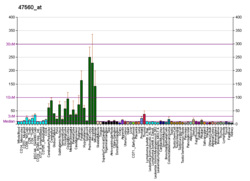
EGF-like module-containing mucin-like hormone receptor-like 1 also known as F4/80 is a protein encoded by the ADGRE1 gene. EMR1 is a member of the adhesion GPCR family. Adhesion GPCRs are characterized by an extended extracellular region often possessing N-terminal protein modules that is linked to a TM7 region via a domain known as the GPCR-Autoproteolysis INducing (GAIN) domain.

EGF-like module-containing mucin-like hormone receptor-like 3 is a protein encoded by the ADGRE3 gene. EMR3 is a member of the adhesion GPCR family. Adhesion GPCRs are characterized by an extended extracellular region often possessing N-terminal protein modules that is linked to a TM7 region via a domain known as the GPCR-Autoproteolysis INducing (GAIN) domain.

Brain-specific angiogenesis inhibitor 3 is a protein that in humans is encoded by the BAI3 gene.

G protein-coupled receptor 64 also known as HE6 is a protein encoded by the ADGRG2 gene. GPR64 is a member of the adhesion GPCR family. Adhesion GPCRs are characterized by an extended extracellular region often possessing N-terminal protein modules that is linked to a TM7 region via a domain known as the GPCR-Autoproteolysis INducing (GAIN) domain.

Latrophilin 3 is a protein that in humans is encoded by the ADGRL3 gene.

Probable G-protein coupled receptor 124 is a protein that in humans is encoded by the GPR124 gene. It is a member of the adhesion-GPCR family of receptors. Family members are characterized by an extended extracellular region with a variable number of protein domains coupled to a TM7 domain via a domain known as the GPCR-Autoproteolysis INducing (GAIN) domain.

G protein-coupled receptor 126 also known as VIGR and DREG is a protein encoded by the ADGRG6 gene. GPR126 is a member of the adhesion GPCR family. Adhesion GPCRs are characterized by an extended extracellular region often possessing N-terminal protein modules that is linked to a TM7 region via a domain known as the GPCR-Autoproteolysis INducing (GAIN) domain.

Probable G-protein coupled receptor 123 is a protein that in humans is encoded by the GPR123 gene. It is a member of the adhesion-GPCR family of receptors. Family members are normally characterized by an extended extracellular region with a variable number of protein domains coupled to a TM7 domain via a domain known as the GPCR-Autoproteolysis INducing (GAIN) domain.

G protein-coupled receptor 128 is a protein encoded by the ADGRG7 gene. GPR128 is a member of the adhesion GPCR family. Adhesion GPCRs are characterized by an extended extracellular region often possessing N-terminal protein modules that is linked to a TM7 region via a domain known as the GPCR-Autoproteolysis INducing (GAIN) domain.

G protein-coupled receptor 112 is a protein encoded by the ADGRG4 gene. GPR112 is a member of the adhesion GPCR family. Adhesion GPCRs are characterized by an extended extracellular region often possessing N-terminal protein modules that is linked to a TM7 region via a domain known as the GPCR-Autoproteolysis INducing (GAIN) domain.

Adhesion G-protein coupled receptor A3 (ADGRA3), also known as GPR125, is an adhesion GPCR that in humans is encoded by the Adgra3 gene.

G protein-coupled receptor 114 is a protein encoded by the ADGRG5 gene. GPR114 is a member of the adhesion GPCR family. Adhesion GPCRs are characterized by an extended extracellular region often possessing N-terminal protein modules that is linked to a TM7 region via a domain known as the GPCR-Autoproteolysis INducing (GAIN) domain.

Probable G-protein coupled receptor 116 is a protein that in humans is encoded by the GPR116 gene. GPR116 has now been shown to play an essential role in the regulation of lung surfactant homeostasis.

G-protein coupled receptor 97 also known as adhesion G protein-coupled receptor G3 (ADGRG3) is a protein that in humans is encoded by the ADGRG3 gene. GPR97 is a member of the adhesion GPCR family. Adhesion GPCRs are characterized by an extended extracellular region often possessing N-terminal protein modules that is linked to a TM7 region via a domain known as the GPCR-Autoproteolysis INducing (GAIN) domain.

Probable G-protein coupled receptor 111 is a protein that in humans is encoded by the GPR111 gene.

Probable G-protein coupled receptor 110 is a protein that in humans is encoded by the GPR110 gene. This gene encodes a member of the adhesion-GPCR receptor family. Family members are characterized by an extended extracellular region with a variable number of N-terminal protein modules coupled to a TM7 region via a domain known as the GPCR-Autoproteolysis INducing (GAIN) domain.

Probable G-protein coupled receptor 133 is a protein that in humans is encoded by the GPR133 gene.

Probable G-protein coupled receptor 144 is a protein that in humans is encoded by the GPR144 gene. This gene encodes a member of the adhesion-GPCR family of receptors. Family members are characterised by an extended extracellular region with a variable number of protein domains coupled to a TM7 domain via a domain known as the GPCR-Autoproteolysis INducing (GAIN) domain.

EGF, latrophilin and seven transmembrane domain-containing protein 1 is a latrophilin-like orphan receptor of the adhesion G protein-coupled receptor family. In humans this protein is encoded by the ELTD1 gene. ELTD1 appears to have a role in angiogenesis, both physiological and pathological in cancer.

Latrophilin 2 is a protein that in humans is encoded by the ADGRL2 gene.




















